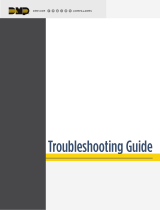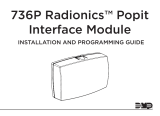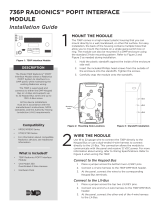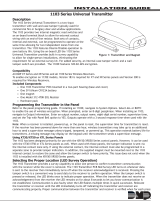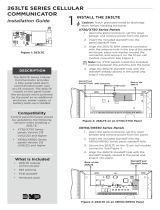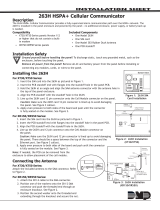Page is loading ...

DESCRIPTION
Figure 1: 263LTE-V
1
INSTALL THE 263LTE-V
Caution: Touch grounded metal to discharge
static before handling the panel.
1. Open the panel enclosure and remove all
power from the panel. If needed, remove
the panel from the enclosure to allow easier
placement of the 263LTE-V.
2. Insert the included stando into the
XT30/XT50 or XR150/XR550 Series panel
stando hole.
3. For XT30/XT50 Series panels, align the
263LTE-V SMA antenna connector with
the antenna hole in the top of the panel
enclosure and secure it on the 12-pin cell
module connector. See Figure 2.
For XR150/XR550 Series panels, secure
the 263LTE-V on the 12-pin cell module
connector. See Figure 3.
4. Allign the 263LTE-V stando hole with the
stando already placed in the panel and
snap it into place.
The 263LTE-V Cellular
Communicator provides a fully-
supervised alarm communication
path over the Verizon LTE network.
The 263LTE-V installs on the panel
inside the enclosure and is powered
by the panel so no additional
enclosure, power supply, or battery
back-up is needed.
Compatibility
Control panel firmware should be
updated to the following versions
when installing a 263LTE-V:
• XT30/XT50 Series panels
with Version 172 or higher
• XR150/XR550 Series panels
with Version 172 or higher
What is Included
• 263LTE-V Cellular
Communicator
• 383LTE antenna
• PCB stando
• 381-2 18” coax cable with
brass washers and nut
(Included only when ordering
the 263LTE-V/381-2)
1
2
3
4
Figure 2: 263LTE-V on an XT30/XT50 Panel
Back of the
263LTE-V
Stando and
Stando Hole
SMA Connector
Figure 3: 263LTE-V on an XR150/XR550 Panel
Stando and
Stando Hole
Back of the
263LTE-V
263LTE-V CELLULAR
COMMUNICATOR
Installation Guide

2 263LTE -V INSTALLATION GUIDE | DIGITAL MONITORING PRODUCTS
1. Navigate to the Dealer Admin site (DMPDealerAdmin.com).
2. Click Customers in the right-side menu and select a customer.
3. Click Add System.
4. Enter a System Name.
5. Select XTLplus from the System Type drop-down menu.
6. Select either Cellular or EASYconnect + Cell Backup in the Connection Type field.
7. Enter the SIM number found on the 263LTE-V label and click Get Status.
8. Enter the Account Number.
9. Select a Rate Plan for the 263LTE-V.
10. Click Activate Cellular Device.
2
Dealer Admin Activation
CONNECT THE ANTENNA
Be sure to only use the included 383LTE antenna when installing the 263LTE-V.
XT30/XT50 Series Panel
Connect the included LTE antenna to the 263LTE-V SMA connector. See Figure 4.
XR150/XR550 Series Panel
1. If you're installing a 263LTE-V/381-2, attach one end of the included coax cable to the
263LTE-V SMA connector.
2. Position one washer onto the other end of the coax cable and push the threaded end
through the antenna knockout hole.
3. Position the second washer onto the threaded end that extends through the antenna
knockout hole and secure the nut.
4. Attach the included LTE antenna to the coax cable SMA connector. See Figure 5.
Note: As an alternative, the coax cable can be connected directly to the 263LTE-V
SMA connector when the coax cable enters the enclosure via conduit.
3
ACTIVATE THE 263LTE-V
Cellular service is required before you can use the 263LTE-V for signal transmission. The
263LTE-V comes ready for activation with SecureCom
TM
Wireless, LLC. Use Remote Link
TM
,
the Dealer Admin
TM
site (DMPDealerAdmin.com), the Tech APP
TM
, or call DMP Customer
Service (1-866-266-2826) to activate the 263LTE-V.
CONNECT THE ANTENNA
LTE Antenna
Figure 4: XT30/XT50 Series Panel
1
2
3
4
Figure 5: XR150/XR550 Series Panel
SMA
Connector
LTE Antenna
Coax Cable
SMA Connector
263LTE-V
SMA
Connector
Coax
Cable
Antenna
Knockout Hole

263LTE-V INSTALLATION GUIDE | DIGITAL MONITORING PRODUCTS 3
TEST THE 263LTE-V
1. Navigate to the Tech APP.
2. Tap Find a Customer then search for a customer.
3. Tap Add a System.
4. Enter a System Name.
5. Scan or enter the Serial #.
6. Select XTLplus from the System Type drop-down menu.
7. Select either Cellular or EASYconnect + Cell Backup in the Connection Type field.
8. Enter the Account Number.
9. Enter the SIM Number found on the 263LTE-V label then tap Get SIM Status.
10. Select a Rate Plan for the 263LTE-V.
11. Tap Activate Cellular Device.
Tech APP Activation
The panel provides a diagnostic function to test the communication integrity and cellular
signal strength of the 263LTE-V to the nearest tower for the cellular carrier. To use the
diagnostic function, reset the panel, enter 2313 (DIAG), and press CMD.
Communication Status
This option tests the individual components of cellular or wireless network
communication.
1. Select CELL STATUS from the Diagnostic menu. Possible test results are shown
in Table 1.
2. Select YES to continue through the remaining component tests or select NO to
stop testing and return to CELL STATUS.
Confirmed Faulty
MODEM OPERATING NO MODEM FOUND
IDENTIFIED NO SIM CARD
TOWER DETECTED NO TOWER
REGISTERED NOT REGISTERED
CONNECT SUCCESS
CONNECT ERROR
NOT ACTIVATED
CELL PATH GOOD NO ACK RECEIVED
Remote Link Activation
1. Navigate to Remote Link and select a panel.
2. Select Program in the top menu and select Communications from the drop-down
menu.
3. Select Cellular Network as the Communication Type and click Activate.
4. Select SIM as the SIM Type.
5. Enter the SIM number found on the 263LTE-V label and click Activate.
6. Select a Rate Plan for the 263LTE-V and click Activate.
4
Table 1: Cell Status Test Results

Designed, engineered, and
manufactured in Springfield, Missouri
using U.S. and global components.
INTRUSION • FIRE • ACCESS • NETWORKS
2500 North Partnership Boulevard
Springfield, Missouri 65803-8877
888.436.7832 | DMP.com
© 2018 Digital Monitoring Products, Inc.
LT-1592 1.01 18312
Specifications
Primary Power 12VDC from panel
Current Draw
Standby 14mA
Alarm 14mA (46mA peak transmitting)
Accessories
381-2 18” Coax Cable
381-12 12’ Coax Extension
381-25 25’ Coax Extension
383LTE Dual Band Antenna (included)
386 Antenna Mounting Bracket
Compatibility
XT30/XT50 Series Version 172 or higher
XR150/XR550 Series Version 172 or higher
Certifications
FCC Part 15: RI7ME910C1NV
Industry Canada: 5131A-ME910C1NV
Underwriters Laboratory (UL) Listed
• ANSI/UL 294 Access Control System Units
• ANSI/UL 636 Holdup Alarm Units and System
Accessory
• ANSI/UL 1023 Household Burglar
• ANSI/UL 1076 Proprietary Burglar
• ANSI/UL 1610 Central Station Burglar
• ANSI/UL 1635 Digital Burglar
• ANSI/UL 985 Household Fire Warning
• ANSI/UL 864 Fire Protective Signaling 9th Edition.
• ANSI/UL 365 Police Sta. Connected Burg Alarm
Units & Systems
• ANSI/UL 609 Local Burg Alarm Units & Systems
FCC INFORMATION
This device complies with Part 15 of the FCC Rules. Operation is subject to the following two conditions:
1. This device may not cause harmful interference, and
2. this device must accept any interference received, including interference that may cause undesired operation.
The antenna used for this transmitter must be installed to provide a separation distance of at least 20 cm (7.874 in.) from
all persons. It must not be located or operated in conjunction with any other antenna or transmitter.
Changes or modifications made by the user and not expressly approved by the party responsible for compliance could
void the user’s authority to operate the equipment.
Note: This equipment has been tested and found to comply with the limits for a Class B digital device, pursuant to
part 15 of the FCC Rules. These limits are designed to provide reasonable protection against harmful interference in
a residential installation. This equipment generates, uses and can radiate radio frequency energy and, if not installed
and used in accordance with the instructions, may cause harmful interference to radio communications. However,
there is no guarantee that interference will not occur in a particular installation. If this equipment does cause
harmful interference to radio or television reception, which can be determined by turning the equipment o and on,
the user is encouraged to try to correct the interference by one or more of the following measures:
• Reorient or relocate the receiving antenna.
• Increase the separation between the equipment and receiver.
• Connect the equipment into an outlet on a circuit dierent from that to which the receiver i
connected.
• Consult the dealer or an experienced radio/TV technician for help.
Industry Canada Information
This device complies with Industry Canada Licence-exempt RSS standard(s). Operation is subject to the following two
conditions:
1. This device may not cause interference, and
2. this device must accept any interference, including interference that may cause undesired operation of the
device.
Le présent appareil est conforme aux CNR d’Industrie Canada applicables aux appareils radio exempts de licence.
L’exploitation est autorisée aux deux conditions suivantes:
1. l’appareil ne doit pas produire de brouillage, et
2. l’utilisateur de l’appareil doit accepter tout brouillage radioélectrique subi, même si le brouillage est susceptible
d’en compromettre le fonctionnement.
This system has been evaluated for RF Exposure per RSS-102 and is in compliance with the limits specified by Health
Canada Safety Code 6. The system must be installed at a minimum separation distance from the antenna to a general
bystander of 7.87 inches (20 cm) to maintain compliance with the General Population limits.
L’exposition aux radiofréquences de ce système a été évaluée selon la norme RSS-102 et est jugée conforme aux limites
établies par le Code de sécurité 6 de Santé Canada. Le système doit être installé à une distance minimale de 7.87 pouces
(20 cm) séparant l’antenne d’une personne présente en conformité avec les limites permises d’exposition du grand
public.
263LTE-V CELLULAR
COMMUNICATOR
/



